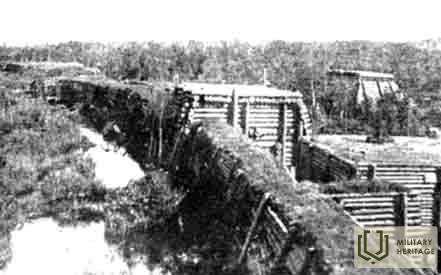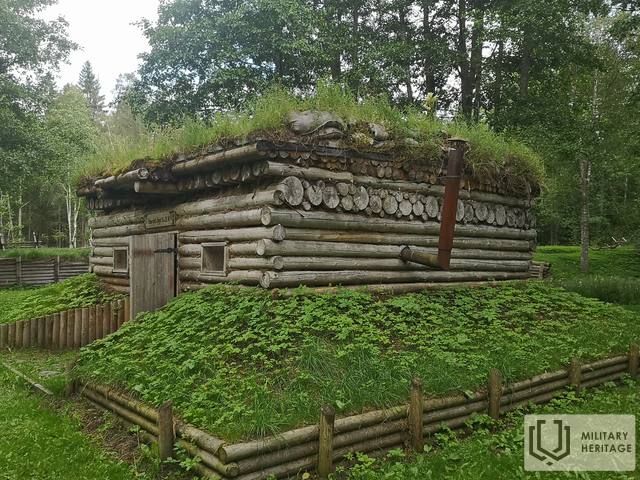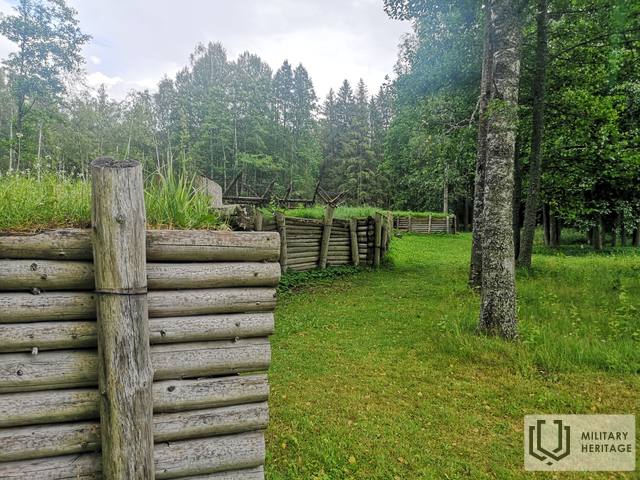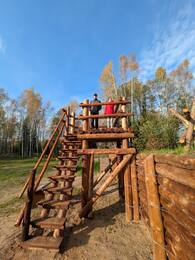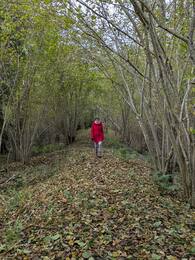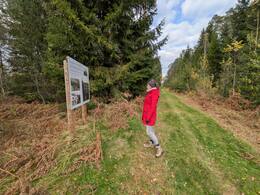German rampart I World War I
On January 23 (10), the command of the Russian 12th Army ordered the Latvian and Siberian Riflemen to restore the previous front position. The Latvian riflemen sent for rest were called back to the front. The 3rd Courland and 4th Vidzeme Latvian Regiments were assigned to the center of the attack, and the 12th Siberian and 54th Siberian Regiments to both flanks. The 4th Vidzeme Latvian Regiment was ordered to attack from the southern slope of Ložmetējkalns at 5:00 a.m. on January 12 with the unit's left flank along both sides of the German rampart, and on the right flank it was to operate together with the 3rd Courland Latvian Riflemen. Suffering heavy losses, the front companies of both regiments occupied the German positions at objective 16 in Maztīreli for some time. Overwhelmed by the German superior force, however, during the day the riflemen retreated to the Ložmetējkalns area. Apparently, the 4th Vidzeme and 3rd Kurzeme regiments launched the attack at different times. Due to the hasty preparation of the complex night battle, physical contact was not established between the soldiers of the two regiments. The attack of the four regiments had no concrete result also because no one centrally led this night combat operation.
The branch of the Latvian War Museum “Christmas Battle Museum” is located in the “Mangaļu” houses of Valgunde parish, Jelgava region. The museum territory houses the Christmas Battle Museum and the First World War fortifications. A reconstructed section of the fortification system is on display — the armoury and the “German rampart” — a fragment of the first line of defense
Source: https://lv.wikipedia.org/wiki/Ziemassv%C4%93tku_kaujas (accessed: 23.05.2021)
Related objects
Christmas Battle Museum
The museum is located in “Mangali” house, Valgunde Rural Territory, Jelgava Municipality, and it is a branch of the Latvian War Museum. It was unveiled in 2005 at the site of the Christmas Battles that occurred during World War I. Unique World War I fortifications still remain at the battle sites. The open-air exhibition of the Christmas Battle Museum reconstructs a section of the fortification system – the trench shelter and part of the first line of German defence – the “German rampart”, which is the only object of this kind in the Baltic states.
The Christmas Battles are one of the best known and most dramatic events of World War I in Latvia. They are an event of special importance in Latvian military and cultural history. Intense fighting took place for six days, leading to heavy casualties. The battles are mainly associated with the attack of Latvian Riflemen against the German Army units, which took place in particularly severe and unfavourable winter conditions. This is an unprecedented case of a major combat operation launched without artillery support.
Today, the museum artefacts found at the sites of the battle are on display. The indoor exhibition is open at certain times, while the exhibition of outdoor fortifications is open every day. Tourist routes and nature trails have been created in the surrounding area.
German rampart
A "German Rampart" is a defensive fortification built by the German army and used during the Christmas Battles of 1916. It consists of an earthen rampart reinforced with wooden structures and barbed wire, forming a shield against attack. This type of fortification was common during World War I to strengthen front lines and protect troops.
The "German Wall" can be viewed by following a 7 km long hiking route, which begins at the Mangaļi House - the Christmas Battle Museum. In the vicinity of the museum - in the nearby forests, a natural trail runs along the "German Wall", which is also managed, that is - easily accessible for pedestrians. It should be taken into account that the "German Wall" is an open-air object - there may be a fallen tree, the terrain is uneven. The "German Wall" also extends further north and crosses the Maztīreļa Bog, but in this area it is overgrown and is more suitable for "adventure" and "expedition" seekers, not "Sunday walkers".
Hiking route (educational trail) near the Christmas Battle Museum
The approximately 7 km long hiking route – the educational trail can be started at the Christmas Battle Museum, where there is a car park and toilets. It is worth taking a map or a photocopy of it with you. The trail is marked along its entire length. It can be walked in different seasons – in summer, autumn, when the leaves are turning color, or in spring, when the primroses and other spring flowers are blooming. It should be taken into account that there are poor mobile communications in the vicinity of the trail. The difficulty level of the trail is easy, but you should take into account the time needed to walk it and get to know all the objects. Surface – forest roads, trails, natural surface, gravel roads. Starting from the Mangaļi Houses in a clockwise direction, it is worth walking the trail not along the gravel road, but along the German Rampart section, which extends the route by about half a kilometer. There are wooden bridges over the ditches. Be careful, because in wet weather they can be slippery.
There are 18 stops along the route, which are equipped with information boards:
- The first line of fortifications of the Russian army – the so-called “Russian Rampart”;
- 3. The starting positions of the Courland Latvian Riflemen Regiment for the Christmas Battles attack;
- Headquarters of the United Latvian Riflemen Division at the beginning of the Christmas battles;
- Russian Army artillery positions;
- 4. Exit positions of the Vidzeme Latvian Riflemen Regiment for the Christmas Battles attack;
- 1. Daugavgrīva Latvian Riflemen Regiment's starting positions for the Christmas Battles attack;
- Neutral zone;
- Barbed wire fences;
- The first line of fortifications of the German army – the so-called “German Wall”;
- A water intake point set up by German army soldiers;
- Artillery shell explosion pits;
- The German army's rear fortification system;
- Viewable positions, bunkers, trenches, bomb craters, memorial stones, etc.
Related stories
A diary entry about the moment when soldiers learn about preparations for the Christmas battles.
The Latvian riflemen and their officers were informed about the beginning of the battle at the last moment. The non-commissioned officer of the 5th Zemgale Latvian Riflemen Regiment, Rūdolfs Ivanovs, described in his diary the last evening before the start of the battle. A short, but vivid and authentic text that shows a very important moment for a soldier – learning about the day of the battle.




